8.2: Intergroup Relations
- Last updated
- Save as PDF
- Page ID
- 104076

- Erika Gutierrez, Janét Hund, Shaheen Johnson, Carlos Ramos, Lisette Rodriguez, & Joy Tsuhako
- Long Beach City College, Cerritos College, & Saddleback College via ASCCC Open Educational Resources Initiative (OERI)
Patterns of Intergroup Relations: Latinx
- Extermination/Genocide: The deliberate, systematic killing of an entire people or nation (e.g. lynching).
- Expulsion/ Population Transfer: The dominant group expels the marginalized group (e.g. deportation).
- Internal Colonialism: The dominant group exploits the marginalized group (e.g. farm workers).
- Segregation: The dominant group structures physical, unequal separation of two groups in residence, workplace & social functions (e.g. schools).
- Seperatism: The marginalized group desires physical separation of two groups in residence, workplace & social functions (e.g. Federal Land Grant Alliance).
- Fusion/ Amalgamation: Race-ethnic groups combine to form a new group (e.g. intermarriage, biracial/bicultural children).
- Assimilation: The process by which a marginalized individual or group takes on the characteristics of the dominant group (e.g. English language only).
- Pluralism/ Multiculturalism: Various race-ethnic groups in a society have mutual respect for one another, without prejudice or discrimination (e.g. bilingualism).
Genocide
As a significant segment of the Latinx population has Indigenous ancestry, the historical genocide against groups native to the Americas, including the United States, is relevant to their experience. In addition, although the lynchings of African Americans in American history have been better documented, there is also the lesser known history of extrajudicial and unlawful killings of Mexicans and Mexican Americans, especially in the Southern part of the United States. For instance, historians William D. Carrigan and Clive Webb (2003) documented and analyzed hundreds of such extrajudicial killings that occurred between 1848 and 1928. In their research titled "The Lynching of Persons of Mexican Origin or Descent in the United States, 1848 to 1928", they cataloged 597 lynchings of persons of Mexican origin in the United States, which they consider a conservative estimate. The lynchings were concentrated in Texas, California, Arizona, and New Mexico and were mostly carried out in the 30-year period immediately after the end of the Mexican-American War, which they described as a period of "unparalleled danger from mob violence" for people of Mexican origin.
Expulsion/Population Transfer
According to the Aguirre & Turner (2007), in the period after the Mexican-American war, the Mexican population in the United States experienced a significant loss of social, political, and economic status and was thus relegated to a source of cheap and expendable labor for the growing labor-intensive industries - agriculture, mining, and railroads -especially in the Southwestern part of the United States. One consequence of this increase demand for Mexican labor is that immigration policies were not restrictive between 1870 and 1930, allowing Mexican workers to enter the United States to freely. However, this changed during the Great Depression in the 1930s and there was a rising tension and an increase in anti-Mexican sentiment. As a result, a repatriation movement began to expel Mexican nationals (as well as U.S. citizens of Mexican descent) from the United States, and over 500,000 people were repatriated between 1929 and 1935 (Aguirre & Turner, 2007).
During the Bracero Program, which was a labor contract between the United States and Mexico that operated from 1942-1964, Congress gave authorization for the Border Patrol to initiate "Operation Wetback." This gave the U.S. Border Patrol wide discretion to stop and search people who "looked Mexican" and who deport anyone who did not have the proper paperwork identifying themselves as participants in the Bracero Program. Between 1954 and 1959, approximately 3.8 million people were returned to Mexico (Aguirre & Turner, 2007).
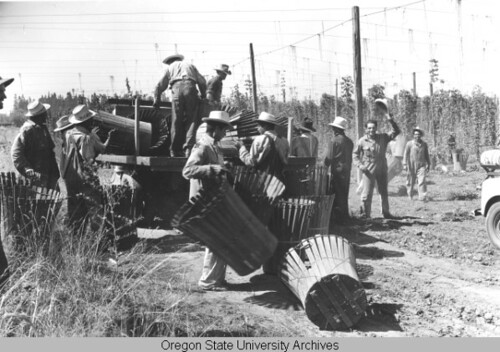
More recently, there have been deportation regimes and ballot efforts to target and deport undocumented Latinx immigrants, such as Proposition 187 (California - 1994), Senate Bill 1070 (Arizona - 2010), House Bill 56 (Alabama - 2011), and the Trump administration's Executive Order 13767 ("Border Security and Immigration Enforcement Improvements"). Sociologist Douglas Massey (2006) suggests that although historically the average standard of living in Mexico may be lower than in the United States, it is not so low as to make permanent migration the goal of most Mexicans. However, the strengthening of the border that began with the 1986 Immigration Reform and Control Act and more recent policies has made one-way migration the rule for most Mexicans. Massey argues that the rise of undocumented one-way immigration of Mexicans is a direct outcome of the laws and policies that were intended to reduce it.
Internal Colonialism
One historical example of internal colonialism is the Bracero Program. Mentioned in the previous section, the Bracero Program was an official agreement between the United States and Mexico to bring Mexican laborers to work in specified industries presumably to meet the labor shortage during World War II. Approximately 5 million Mexican workers were granted temporary work visas throughout the course of the program, which operated from 1942-1964. Employers were required to pay prevailing local wages and provide workers with minimal worker protections and conditions. However, the program was fraught with problems including terrible work conditions, abuse, and many workers were not paid for their work. (Aguirre and Turner, 2007)
According the USDA, in 2016 over 70% of the farmworker labor force in the United States was foreign-born, mostly from Latin America. Approximately 21% of the farm worker labor force were authorized immigrants with permanent residency or green cards and 48% of the farm worker labor force was made up of unauthorized immigrant workers. As we know from other research studies, such as Milkman et al (2010), undocumented workers are more susceptible to workplace violations, low wages, and threats from employers.
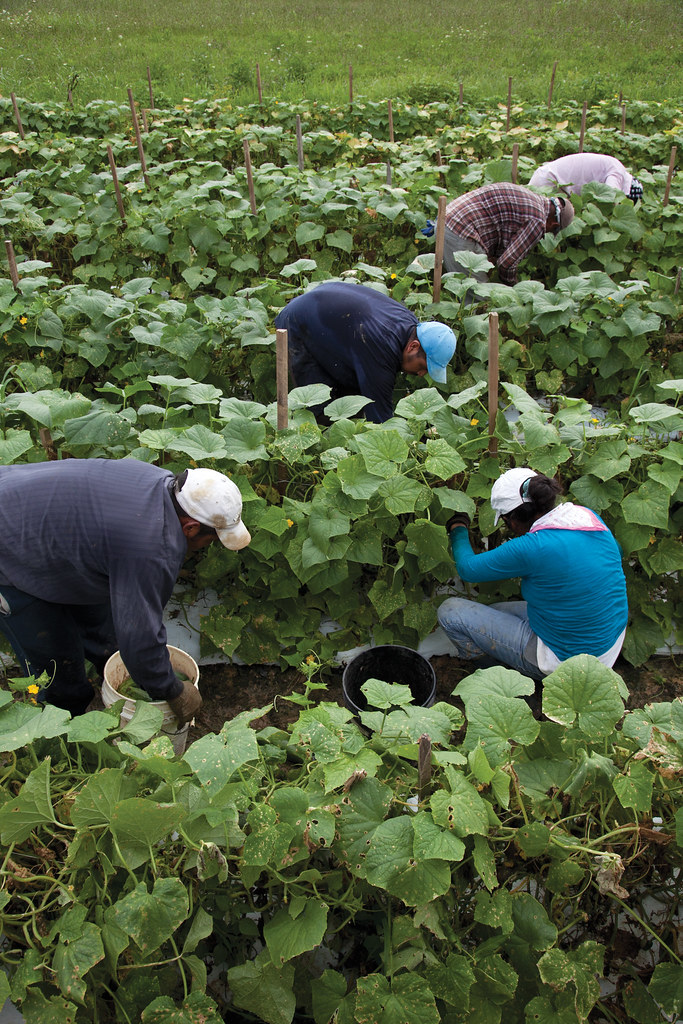
Segregation
An example of de jure segregation relates to the education of Mexican American children in California in the early 1900s. Moll & Ruiz (2002) argue that two methods of social control were employed at this time to undermine the educational attainment and social mobility of the Mexican population: 1) exclusion from schooling, and 2) control over the content and purpose of schooling. The latter was done mainly through the official segregation of schooling by playing Mexican kids into "Mexican schools". In the important court case Mendez v. Westminster (1947), Sylvia Mendez was denied entry in to the neighborhood school in Orange County, California and was instead assigned to the "Mexican school" by school officials. Her parents sued the school district, organized with other parents and filed a class action law suit against several districts, and the case made its way to the U.S. District Court. The District Court judge agreed with the Mendez family and ordered that the school districts to cease their discriminatory practices against students of Mexican origin in their public schools. Several organizations, including the National Association for the Advancement of Colored People (NAACP), filed amicus briefs (friends of the court briefs) in support of the Mendez family. Eight years later, its author Thurgood Marshall would present to the Supreme Court in Brown v. Board of Education of Topeka (1954), a case that would help to end school segregation throughout the United States.
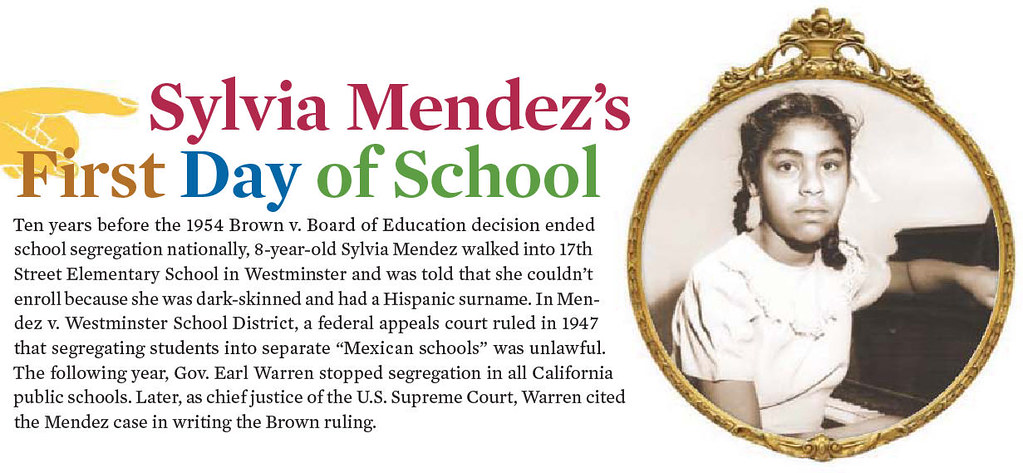
More recently, demographers have found that Latinx-white residential segregation, as measure by the dissimilarity index, has remained constant over the decades. Furthermore, De la Roca et al (2018) found clear quantitative evidence that residential segregation in metropolitan areas has a strong, negative association with the educational outcomes and labor market attainment of native-born Latinx people and Black Americans. Among the Latinx groups, they found residential segregation has a more significant negative outcomes for young adults of Puerto Rican and Dominican ancestry.
Separatism
During the Chicano Movement, there were some groups and organizations who planned to separate themselves from mainstream society, promoting a type of Chicano Nationalism that advocated for a self-contained and insular community. For example, the Brown Berets were created during the Chicano Movement to address the issues of police brutality, institutional racism, educational inequality, and land rights.
Fusion/Amalgamation
With regard to racial and ethnic intermarriage, in 2015 approximately 27% of Latinx newlyweds were intermarried, the second highest rate among the four major racial and ethnic groups. This has also led to an increase in the percentage of multiracial babies in the United States. In 2015, 14% of all babies under the age of 1 living with two parents were multiracial or multiethnic. Among the 14%, a large percentage (42%) were babies with one Latinx parent and one white parent and 22% had multiracial or multiethnic parents. A lower percentage of multiracial babies had one Latinx parent and one Black parent (5%) and one Latinx parent and one Asian parent (4%).
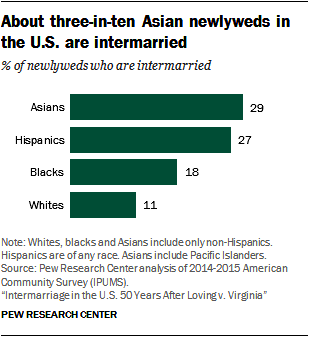
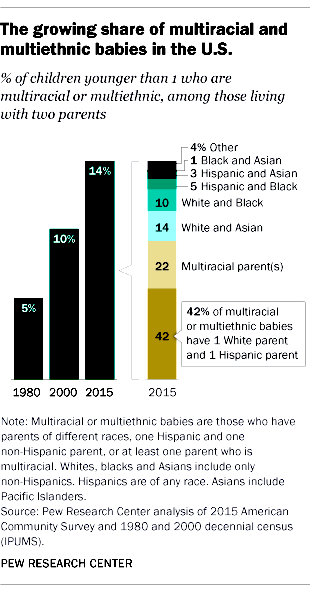
Assimilation Patterns
While white ethnics, Cubans, Asians, and Middle Easterners tend to follow the traditional assimilation pattern, three significantly large Latinx minorities have not followed this more traditional pattern: Mexican Americans, Puerto Ricans, and Cuban Americans. The assimilation patterns for these groups differ due to propinquity, method of migration, and let us not mince words, racism. A relatively smaller percentage of all Mexican immigrants to the United States do not follow the traditional assimilation pattern. This is partly due to the propinquity of the mother country, the nearly continuous new migration stream, a relatively high rate of return migration, racism, and in some cases, involuntary immigration in that parts of Mexico have been annexed by the United States so that some people’s native land quite literally changed overnight—they went to bed Mexican and woke up American.
Puerto Ricans, following the treaty that concluded the Spanish American War, became citizens of the United States, albeit citizens without suffrage. Therefore, Puerto Ricans, who are already citizens, have little incentive to assimilate and, like their Mexican counterparts, are physically close to their homeland, maintain a nearly continuous migration stream onto the mainland, and have a relatively high rate of return migration. Puerto Rico is a historically poor colony of the United States populated primarily by Spanish-speaking, Hispanic-surnamed descendants of African slaves. Thus, entrenched intergenerational poverty, coupled with language difficulties and racism, have prevented assimilation. Most Puerto Ricans who live on the mainland live in poor, inner city neighborhoods in New York and Chicago. Neighborhoods that are not ethnic enclaves but are rather huge concentrations of the poor, undereducated, and Black underclass.
Cuban Americans, perhaps because of their relative wealth and education level at the time of immigration, have fared better than many immigrants. Further, because they were fleeing a Communist country, they were given refugee status and offered protection and social services. The Cuban Migration Agreement of 1995 has curtailed legal immigration from Cuba, leading many Cubans to try to immigrate illegally by boat. According to a 2009 report from the Congressional Research Service, the U.S. government applies a “wet foot/dry foot” policy toward Cuban immigrants; Cubans who are intercepted while still at sea will be returned to Cuba, while those who reach the shore will be permitted to stay in the United States.
Pluralism/Multiculturalism
There has undoubtedly been in increase in the incorporation of some aspects Latinx culture in mainstream America, especially with regard to food (e.g. eating tacos), music (e.g. listening to Spanish language crossover pop songs), symbolic traditions (e.g. using piñatas at birthday parties) and celebrations (e.g. celebrating Día de los Muertos). However, as we know from the previous experiences of other communities of color, partaking in aspects of culture does not necessarily translate into better racial and ethnic relations. For example, as white Americans were listening to the music of Louis Armstrong in the 1930s and 1940s, most African Americans were suffering from the effects of Jim Crow era racism and segregation. Similarly, as Ritchie Valens' "La Bamba", a rock and roll remake of a traditional Mexican song, became a rare Spanish language crossover hit in the 1950s, Mexican-Americans were being subjected de facto segregation, deportation regimes such a Operation Wetback, and discrimination. There is also the tendency of American mainstream society to "whitewash" Latinx culture and for corporations to appropriate culture for economic gain, such as the celebration of Cinco de Mayo and more recently, the Disney corporation's attempt to trademark "Day of the Dead" (Flores, 2013).
After the 2020 election, Latinx representatives now make up approximately 12% of the U.S. House of Representatives (up from 10% from the previous election). Although the increase represents progress, they are still underrepresented as they make up 18.5% of the total population. There are currently 6 Latinx Senators. Five were elected and one was appointed by the Governor of California. Three of the Senators are Democrats and 2 are Republicans, reflecting the diversity of political affiliation within the Latinx electorate. In terms of economic power, according to a Latino USA publication, while Latinx workers make up 17% of the U.S. labor force, they only make up 4% of company executives (Swerzenski, Tomaskovic, & Hoyt, 2020). They also found difference across metropolitan areas. Miami had the highest percentage of Latinx executives (25%) and New York had the lowest (4.5%). Houston (10%) and Los Angeles (8%) were in between but closer to New York than Miami. The authors recommend increasing the the percentage of Latinx workers in mid-level management positions and also "acknowledging blindspots that often exclude [Latinx] workers, such as non-Latinx employers recognizing unconscious biases in their communication styles and providing opportunities to professionally use their cultural competencies" (Ibid, p. 1).
Contributors and Attributions
- Ramos, Carlos. (Long Beach City College)
- Tsuhako, Joy. (Cerritos College)
- Minority Studies (Dunn) (CC BY 4.0)
- Introduction to Sociology 2e (OpenStax) (CC BY 4.0)
Works Cited
- Aguirre, A. & Turner, J. (2007). American Ethnicity: The Dynamics and Consequences of Discrimination. 5th Edition. New York: McGraw Hill.
- Carrigan, W. & Webb, C. (2003). The lynchings of persons of Mexican origin or descent in the United States, 1848 to 1928. Journal of Social History, Vol. 37, No. 2 (Winter) Oxford University Press.
- Castillo, M. & Simnitt, S. (2020). Size and composition of the U.S. agricultural workforce. USDA Reports.
- Cisneros, H., Morales, S., Racho, S., Galán, H., Moreno, M., Cozens, R., Beasley, B., ... NLCC Educational Media. (1996). Taking Back the Schools. In Chicano!: History of the Mexican American Civil Rights Movement. [Video]. Los Angeles, CA: National Latino Communications Center.
- De la Roca, J., Ellen, I., & Steil, J. (2018). Does segregation matter for Latinos?. Journal of Housing Economics. Vol. 40, p. 129-141.
- Flores, A. (2013, May 8). Disney withdraws trademark filing for 'Dia de los Muertos'. Los Angeles Times.
- Massey, D. S. (2006, August). Seeing Mexican immigration clearly. CATO Unbound: A Journal of Debate.
- Moll, L. & Ruiz, R. (2002). The Schooling of Latino Children in Suarez-Orozco, M. and Paez, M. (Eds.). (2002) Latinos: Remaking America. Berkeley: UC Press
- Swerzenski, J.D., Tomaskovic, D.T., & Hoyt, E. (2020, January 27). Where are the Hispanic executives? Latino USA. The Conversation.

